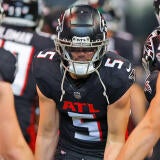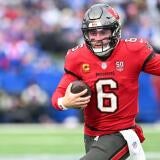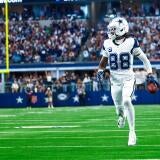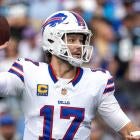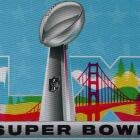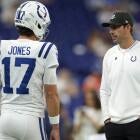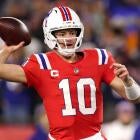Packers at Bears preview: Channel, time, how to stream, game pick and what to know about NFL's 2019 kickoff
We dive deep into the first game of the NFL season and tell you what you can expect in Packers-Bears tonight
The NFL is back tonight with the Chicago Bears and Green Bay Packers -- one of the best rivalries in the sport -- opening the season on Thursday night.
Almost exactly a year ago, the Bears and Packers played one of the most exciting games of the 2018 NFL season. The first Sunday night bout of the year, this was a game that had everything: historic rivals, stars on both sides of the field, incredible performances, and a dramatic comeback led by an all-time great.
Tonight, we get to do it all over again. And as we'll see on the field, much is the same about these two teams as they prepare to do battle for the 199th time, but much is also different.
The Bears are returning nine of the 11 starters from last year's offense, with Mitchell Trubisky and company now working in Year 2 of Matt Nagy's system. The Packers are of course still quarterbacked by the legendary Aaron Rodgers, whose No. 1 receiver is still Davante Adams and who still has one of the league's best offensive lines protecting him. The Bears are also bringing back nearly every important contributor from last year's NFL-best defense, with eight of 11 starters returning for a rerun.
But the Bears have swapped out running back Jordan Howard for rookie David Montgomery. Former defensive coordinator Vic Fangio is now the head coach of the Broncos, while slot corner Bryce Callahan followed him to Denver and has been replaced by former Browns and Jets corner Buster Skrine. (Fangio has been replaced by former Colts coach Chuck Pagano, who spent last season working as a consultant for several teams.) Safety Adrian Amos signed with, well, the Packers, and was replaced by ... former Packers safety Ha Ha Clinton-Dix.
Green Bay has a new coach (and thus new offense) for the first time since 2006, with Matt LaFleur being hired to take over for Mike McCarthy. Aaron Jones now seems like the undisputed feature back, while second-year wideout Marquez Valdes-Scantling seems to have locked down the No. 2 job and Geronimo Allison has moved into the slot. And all of those changes pale in comparison to the overhaul the Packers have conducted on defense, where they spent a combined $154 million this offseason to bring in Preston Smith, Za'Darius Smith, and the aforementioned Amos to anchor coordinator Mike Pettine's unit; traded up to land former Maryland safety Darnell Savage in the draft; let Clay Matthews leave in free agency and made Mike Daniels a salary-cap casualty near the beginning of camp.
How will all of those changes affect this matchup, which doubles as the first game of the NFL's 100th season? We're glad you asked, because that's exactly what we're here to break down.
Looking for more on Thursday night's season opener? Jared Dubin joined Will Brinson to break down the game on the latest episode of the Pick Six Podcast. Listen below:
Info on Packers at Bears
- Date: Thursday, Sept. 5
- Time: 8:20 p.m. ET
- TV channel: NBC
- Streaming: fuboTV (Try for free)
- Odds: Bears -3, O/U 46.5 (via SportsLine)
Get more NFL picks, betting analysis and access to proven computer simulations and fantasy tools by joining SportsLine. Former Vegas bookmakers give perspective from the other side of the counter, while red-hot experts with decades of experience handicapping games give their top plays. Join SportsLine here to see this week's winners.
When the Packers have the ball
Let's start with what we know, which, due to coaching and schematic changes, is mostly how things will play out on the Bears' side of the ball.
Chicago will almost surely play sides with its primary cornerbacks, with Kyle Fuller lining up at left corner and Prince Amukamara lining up on the right. They each played 99 percent of their snaps on those sides of the ball last season, and there's no real reason to expect that will change with Chuck Pagano replacing Fangio as the defensive coordinator. Chicago will move star pass rusher Khalil Mack around to try to get him into favorable matchups, bringing him off the left (51.5 percent of his snaps last season) or right side (48.5 percent) depending on formations and alignments, while Leonard Floyd will rush across from him. Akiem Hicks will bring the pressure up the middle, while Roquan Smith will roam sideline-to-sideline and Eddie Jackson will patrol the back end looking to make plays on the ball.
All of those knowns inform what we can and should expect the Packers to do offensively. Davante Adams lined up most often as the left outside receiver last season, spending 52 percent of his snaps there while aligning outside right on 27 percent and in the slot on 21 percent. Given the respective strengths of the Bears' cornerbacks and the greater efficiency of passes to slot receivers, however, LaFleur would do well to move Adams around quite a bit more than McCarthy did last season.
Skrine is the clear weakest link among Chicago's trio of DBs, and Adams could absolutely eat against him on the inside. Skrine allowed 537 yards on passes against slot wideouts last season, third-most in the NFL, per Pro Football Focus, while his five touchdowns allowed in the slot were most in the league. Allison is expected to be the Packers' primary slot man, but because Chicago mostly keeps its corners aligned the same way, it makes sense to play to the matchup so that Rodgers has as easy a time as possible finding his primary target. If the Bears want to have Fuller and Amukamara tangle with Valdes-Scantling and Allison all game while Rodgers peppers Adams with throws, that's to Green Bay's benefit, not Chicago's.
Similarly, we should expect Mack to rush mostly off the left edge in this game. Bakhtiari is arguably the best overall offensive lineman in the entire league, and while Bulaga is an above-average right tackle, it is undoubtedly easier to beat him than it is Bakhtiari. Putting Mack in the best possible position to succeed in disrupting the Green Bay offense means letting him work against the weaker of the team's two tackles -- even if it means Rodgers has a better view of exactly where his rush is coming from than if he were on the blind side.
While we don't know exactly what the new LaFleur-led passing attack will look like, one thing we can undoubtedly expect is for more of Rodgers' passes to come off play-action fakes. Rodgers threw after a run fake on only 20.1 percent of his attempts last season, per PFF, a figure that ranked 30th out of 37 qualified passers. LaFleur comes from the McVay/Shanahan coaching tree, where they run some of the most play-action in the league. Jared Goff ranked second among those same 37 quarterbacks in play-action rate last year, while Marcus Mariota ranked fifth. (LaFleur spent last season as Tennessee's offensive coordinator.) Expect a big boost for Rodgers in this area, and for the Packers to look to create big plays on throws up the seams and on crossing routes when he fakes the run before popping back up to throw.
While there's a school of thought that play-action effectiveness requires a dominant or at least strong rushing performance, research has shown that to be far less true than is commonly believed. So even though the Bears are returning almost every important piece from last year's No. 2 run defense by DVOA, pursuing a play-action-heavy passing attack is still a beneficial strategy.
Those fakes could even help Jones get loose in the run game, helping boost his efficiency upward from the 20 carries for 69 yards he has in his career against the Bears. Rushing directly at a stud interior lineman like Hicks is not the best idea in the world, but a zone-based scheme that allows Jones to flow behind blockers until a crease opens and then burst through it is likely what we'll see in action. The Rams were the league leaders in zone runs last season, per Sports Info Solutions, while the Titans ranked fifth. The Packers ranked just 29th, so this will mark a pretty significant change in the way their rushing attack actually looks. (The 2018 Bears ranked second in yards allowed per carry on zone runs, for what it's worth, yielding just 3.2 yards a pop.)
Perhaps the biggest difference on this side of the ball, however, is not the change in offensive play-callers for the Packers, but defensive play-callers for the Bears. Asked by ESPN.com last week whose defenses are the most difficult to attack, Sean McVay, Kyle Shanahan, and LaFleur all gave the same answer: Vic Fangio.
So who wins Packers vs. Bears? And which side of the spread cashes in over 50 percent of simulations? Visit SportsLine now to see which side of the Packers vs. Bears spread to jump on Thursday, all from the advanced model that is up more than $7,000 on its top-rated NFL picks.
When the Bears have the ball
We know far more about what the schemes and matchups will look like here than we did in the section above, largely because the same play-callers are returning to the fold.
We know what to expect from Matt Nagy's offense: an Andy Reid-style attack that utilizes lots of quick, decisive routes, play-action fakes, misdirection, and creativity to get playmakers isolated in open space with favorable matchups. And we know what to expect from Mike Pettine's defense: an aggressive pass rush that relies on a heavy dose of blitzing designed to force the opposing quarterback into mistakes. Green Bay's 29.1 percent blitz rate was the eighth-highest in the NFL last season, per Football Outsiders.
However, Green Bay's defensive overhaul makes the matchups look far different in this game than they did a year ago.
| POS | 2018 | 2019 |
|---|---|---|
| DE | Muhammad Wilkerson | Dean Lowry |
| NT | Kenny Clark | Kenny Clark |
| DE | Mike Daniels | Montravius Adams |
| EDGE | Clay Matthews | Preston Smith |
| ILB | Oren Burks | Oren Burks |
| ILB | Blake Martinez | Blake Martinez |
| EDGE | Nick Perry | Za'Darius Smith |
| EDGE | Reggie Gilbert | Rashan Gary |
| DB | Kevin King | Jaire Alexander |
| DB | Kentrell Brice | Kevin King |
| DB | Ha Ha Clinton-Dix | Adrian Amos |
| DB | Tramon Williams | Darnell Savage |
| DB | Jaire Alexander | Josh Jackson |
| DB | Josh Jackson | Tramon Williams |
Preston and Za'Darius Smith will now come off the edges for Pettine's defense, with some help from rookie Rashan Gary and veteran Kyler Fackrell. Second-year defensive back Jaire Alexander is the team's No. 1 corner, while Kevin King seems the likely No. 2. Adrian Amos and Darnell Savage are at safety, while Tramon Williams will play in the slot and Josh Jackson will again get plenty of work as well. Up front, Mike Daniels and Muhammad Wilkerson are gone, replaced by Dean Lowry and Montravius Adams. This is a much different look from what the Bears saw from Green Bay last year.
Perhaps the area where this will help Chicago most is the run game. Green Bay finished last season ranked just 24th in rush defense DVOA, and the unit's second-best run defender (Daniels) now plays for the Lions. Clark is an absolute monster on the interior, but he's only one guy. The Bears are returning the core of an above-average run-blocking offensive line, and have replaced a plodding runner who rarely broke tackles (Howard, who ranked 66th in PFF's Elusive Rating among the 72 backs who had at least 50 carries last season) with a dynamic rusher who led the nation in missed tackles forced during his final year in college (Montgomery).
The Bears should also have advantages in the short-area pass and screen game, with Tarik Cohen providing an extreme speed and athleticism advantage against linebackers Oren Burks and Blake Martinez. The Bears did not get Cohen very involved in the game plan in two matchups with Green Bay last season (18 total touches for 96 yards and a touchdown), and although Nagy has been open about not wanting to overuse the gadget back, this is a good situation for Cohen to see 8-12 touches and break some big plays.
The Bears will presumably be using Allen Robinson and Taylor Gabriel as their perimeter receivers once again, while second-year wideout Anthony Miller spends most of his time in the slot. That will leave Miller matched up most often against Tramon Williams, who rotated between safety, slot, and outside corner last year and, according to PFF, allowed a ridiculous eight touchdowns and 125.6 passer rating on throws in his direction. Nagy and Trubisky should look to attack that matchup early and often, which should help open things up on the outside.
Trubisky will, of course, need time to throw if he's to attack downfield, which he did more often than all but one quarterback last season. Throws at least 20 yards in the air accounted for 16.8 percent of Trubisky's total in 2018, per PFF, second to only Buffalo's Josh Allen. Trubisky was only varyingly effective on those throws, however, with 73 attempts turning into 877 yards, seven touchdowns, and six picks. The Bears allowed pressure on Trubisky only 29.6 percent of the time last season, the eighth-lowest rate in the league, so he should at least have time to survey his options, assuming the front can hold up against Green Bay's revamped pass rush.
The Bears may be working without one of his release valves in tight end Trey Burton, who did not make much of an impact last season and has spent much of training camp and the preseason injured. If he sits, third-year man Adam Shaheen will likely fill in. We have not seen much of Shaheen through two NFL seasons, but he is enormous (6-foot-6, 257 pounds) and a strong athlete, and could provide a different look than any other Bears receiver.
Prediction: Bears 23, Packers 20




